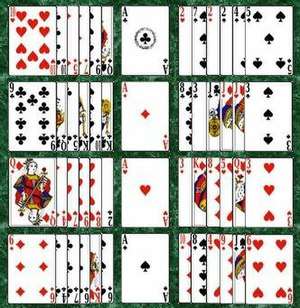Beleaguered Castle
Beleaguered Castle is a patience or solitaire card game played with a deck of 52 playing cards. It is sometimes described as "Freecell without cells" because its game play is somewhat akin to the popular solitaire computer game of that name but without extra empty spaces to maneuver. Beleaguered Castle is also called Laying Siege and Sham Battle.
| A Patience game | |
| Named variants | Castle of Indolence, Citadel, Selective Castle, Siegecraft, Streets and Alleys, Stronghold |
|---|---|
| Family | Castle |
| Deck | Single 52-card |
| See also Glossary of solitaire | |
Rules
First, the player removes the aces from the deck and aligns them vertically without overlapping them to form the foundations. Then cards are dealt to the left and right of the aces, forming eight rows of six overlapping cards each, in a distinctive layout with "wings" on either side of the foundations.

The top card of each row (the cards that are exposed) is available for play either on the foundations or on any other row. The foundations are built up to kings by suit. Cards in the rows are built down in sequence regardless of suit. Once a row becomes empty, it can be filled by any card.[1]
The game is won when all of the cards are built onto the foundations. However, this is easier said than done because most games are doomed to fail in just a few moves.
Variations
In light of how difficult the standard game is to complete due to a poor draw, many variations exist, including:
- In Citadel, any card can be dealt onto the foundations during dealing. The other cards that aren't built are played as in Beleaguered Castle.
- In Streets and Alleys, the aces are included in the shuffling, resulting in the rows at the left of the foundations having seven cards each.
- In Selective Castle, cards are dealt and played as in Streets and Alleys, but the player has the freedom to choose the starting card for each foundation.
- Siegecraft allows an extra cell for any card to be placed on it to help in uncovering key cards, making it easier. The cell can only accommodate one card.
- Stronghold, invented by Thomas Warfield, is Streets and Alleys with the game play of Siegecraft, allowing an extra cell to accommodate a card.
- Castle of Indolence is played with two decks (and hence eight foundations). Cards can be moved to the foundations regardless of suit. The top cards of four reserve piles (initially holding 13 cards) are available for moving on the foundations or rows.
- Fortress and the closely related Chessboard both have five rows on each side of the foundations and allow building of sequences up and down in the same suit.
Pop culture
In the 2011 film Source Code, a card sequence from Beleaguered Castle forms the call sign for the Source Code program.
See also
- List of solitaires
- Glossary of solitaire
References
- Solitaire Games. Archived December 23, 2010, at the Wayback Machine.
